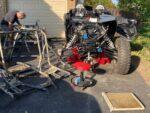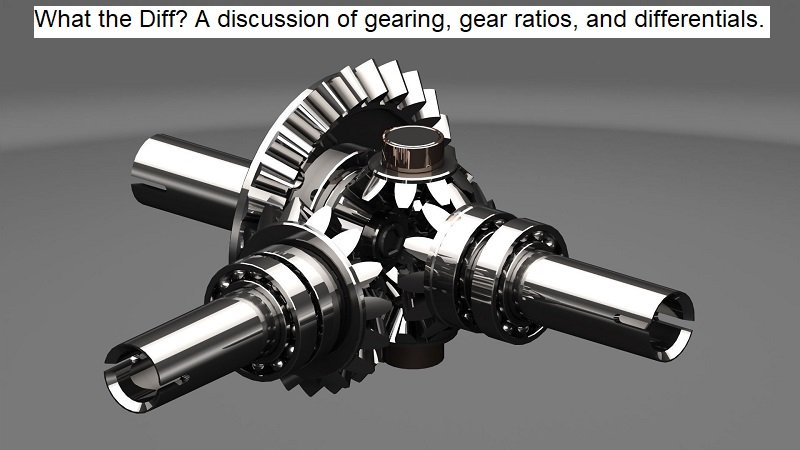Bench racing is a time-honored tradition of theoretically figuring out what vehicle is better based on numbers. Sometimes the leads to people actually racing, but usually, it is like fisherman getting together after a day on the water. One whopper of a story is followed by a bigger story until everyone is drunk, or their wives make them go home. The bench racing number of the day today is Corner Travel Index.
What is Corner Travel Index?

CTI measures a vehicle’s maximum travel at each corner of the vehicle. As you can see in the picture above you lift opposing wheels until any tire not on a lift platform leaves the ground. You then measure from the bottom of each tire to the ground. There are two methods Estimated and Certified. Estimated is a two-wheel measurement that is calculated to a theoretical movement. Certified is doing one setup and then repeating the process for the other corners. Important note, tire pressure must be at 15PSI to get an accurate CTI score.
Estimated: CTI = (FPT + RDT) x 10 x 2 Example: (19 ½ + 18 ¾) x 10 x 2 = 765 CTI
Certified: CTI = (FPT + RDT + FDT + RPT) x 10 Example: 19 ½ + 18 ¾ + 19 ¼ + 18 ½] x 10 = 760 CTI
Why does this matter?
Frankly, it doesn’t. It is like trying to figure out what car is faster based on how much horsepower they make. In theory, it tells you how well your vehicle’s suspension articulates before you would lose traction. It doesn’t take into consideration, tires, vehicle weight, body shift, lockers, limited slip or open differentials, etc… It only tells you how far your suspension moves before a tire will leave the ground and allows you to argue with your buddies and measure who has more theoretical travel.
That isn’t to say there is no use to CTI. It is good to see the limits of your suspension in a controlled and safe environment, and yeah bragging rights matter as well.
CTI Versus RTI

Ramp Travel Index or RTI has the same issues as CTI. RTI has more issues in that many outside factors can increase or decrease the RTI value. Driver skill/courage on the ramp, angle of the ground, the ramp angle, weight distribution all change RTI. The RTI calculation is also significantly more complex, and several other factors like tire pressure can alter the RTI number. RTI does account for body shift and does more accurately show how the vehicle will actually traverse terrain on a side hill versus CTI.
With ramp: r= (d/b)x1000 where b is the wheelbase, d is the distance traveled up the ramp, and r = the ramp calculated index. It leaves a lot of room for variables in measurements.
Verdict
We don’t think that either measurement on its own is conclusive. We also don’t think you should build your rig just to score high on either chart. What we do think is CTI is better for gauging your vehicle and experiencing the full articulation of your suspension before you go off-road. Knowing the limits of your vehicle without damaging it is important and can mean the difference between taking the wrong line off-road or the right line over an obstacle. RTI is fun to see who “flexes” better waiting to get on the trail.
The entire concept of Corner Travel Index (the formulas and methodology) was developed by my team at Metalcloak. We developed it is a better way of testing the capabilities of a suspension. At the time all we saw were manufacturers using RTI to show off what their suspension could do, but RTI does not represent what you are more likely to see on an average trail. CTI shows your capabilities and your limitations – and almost always will show what problems you are going to experience on the trail – so it is a great test of your suspension before you go out into real world playing.
Matson Breakey







Great post. BTW, it would be good to know that the entire concept of Corner Travel Index (the formulas and methodology) was developed by my team at Metalcloak. We developed it is a better way of testing the capabilities of a suspension. At the time all we saw were manufacturers using RTI to show off what their suspension could do, but RTI does not represent what you are more likely to see on an average trail. CTI shows your capabilities and your limitations – and almost always will show what problems you are going to experience on the trail – so it is a great test of your suspension before you go out into real world playing.
Thank you for commenting! I agree that the CTI is a better indicator of your vehicles limitations and capabilities. It is definitely a great way to test and compare in a controlled environment. I think an interesting twist to the CTI formula would be load calculations. Having a sensor in the plate that determines weight shift for traction calculations. I think we would see that sometimes additional flex is overcome by better weight transfer that creates traction.